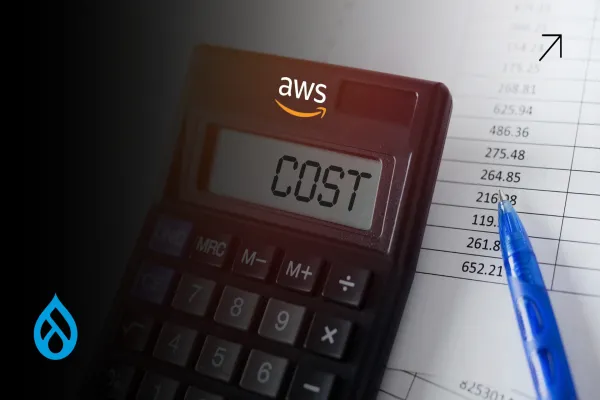When a growing digital publishing enterprise approached us with concerns about their rising AWS spend, we immediately recognized an opportunity; not just to cut costs, but to re-architect their entire infrastructure for long-term sustainability. The client had recently migrated to a Drupal CMS from a legacy platform, seeking scalability and performance. However, while Drupal gave them the content flexibility they needed, their AWS bill told a different story - inefficiencies, underutilized services, and a lack of environment-specific tuning were draining their cloud budget.
We had a clear goal from the outset: make Drupal on AWS work smarter, not harder. The outcome? A 53% reduction in monthly AWS costs within three months, while improving overall system performance.
Identifying Inefficiencies in a High-Traffic Drupal Environment
The client's infrastructure was set up with good intentions but lacked strategic oversight. Drupal was deployed on AWS using a default setup that worked fine for a staging environment, but in production, it was a ticking time bomb. EC2 instances were over-provisioned. RDS databases were scaled without read replicas. Static files were served directly from the web tier, completely bypassing S3 or CloudFront. On paper, they had a scalable setup, but in practice, AWS and Drupal weren’t aligned for performance or cost.
Drupal and AWS are both powerful on their own, but without tuning, the combination can quickly become expensive. Our job was to bridge that gap with a measurable impact.
Optimizing Drupal on AWS Without Compromising Performance
Our team began with a cloud architecture audit. We analyzed usage patterns, Drupal cron jobs, module behaviors, and real-time traffic distribution across time zones. We also looked at AWS-specific factors- EBS throughput, RDS storage classes, CloudWatch insights, and IAM role redundancies. By using this data to inform our decisions, we rebuilt the stack, still fully on AWS, still fully Drupal, but now tuned for reality, not assumptions.
We containerized Drupal with ECS Fargate to reduce idle resource consumption. PHP-FPM workers were autoscaled based on CPU metrics, not blanket assumptions. We moved media assets to S3 and used CloudFront for delivery, reducing bandwidth charges by over 40%. The Drupal CMS remained untouched from a content and editorial standpoint, but what changed behind the scenes was transformative.
Cost Reduction Without Downtime: Our Approach to Migration
There was no “lift and pray” approach. Everything was rolled out in blue-green deployments to prevent disruption. Because the client had multiple production environments for regional content hubs, we staggered the migration and benchmarking in weekly sprints. Drupal’s modularity on AWS made this much easier than expected. We didn’t need to reinvent the wheel; just optimize how it was spinning.
One of the most overlooked areas was the misuse of reserved instances. The team was using on-demand pricing for services with highly predictable usage patterns. We shifted those workloads to reserved instances and saved 27% immediately. Another win came from optimizing the use of Amazon Aurora over standard RDS, allowing for better connection handling with Drupal’s database-heavy architecture.
From High AWS Spend to Predictable Cloud ROI
By month three, the client saw a 53% drop in AWS costs. But this wasn’t just about the numbers. It was about predictability. They could finally forecast cloud spend against content campaigns. Their editorial teams didn’t need to wait on devs for performance tweaks because the infrastructure was working with Drupal, not against it.
Running Drupal on AWS isn’t just a technical decision; it’s a business one. And when done right, it delivers ROI in both performance and cost. We didn’t change the CMS. We didn’t ask the client to adopt a new tech stack. We simply made AWS and Drupal talk to each other the way they should.
Why Drupal and AWS Need Strategic Alignment
Too often, teams deploy Drupal on AWS with a set-it-and-forget-it mindset. That leads to high costs and low performance. Our experience shows that with the right strategy; the same stack can drive better results. Drupal and AWS are not inherently expensive, but misconfigured, they can be a drain on resources.
Every feature of AWS, whether it’s auto-scaling groups, managed databases, or serverless options, can amplify what Drupal offers. But without cost governance, you’re just scaling waste. The real value comes from aligning your CMS and your cloud around usage data, not guesswork.
We don’t just host Drupal on AWS. We make Drupal work for your AWS spend. The difference is in the details, and the results are provable.





